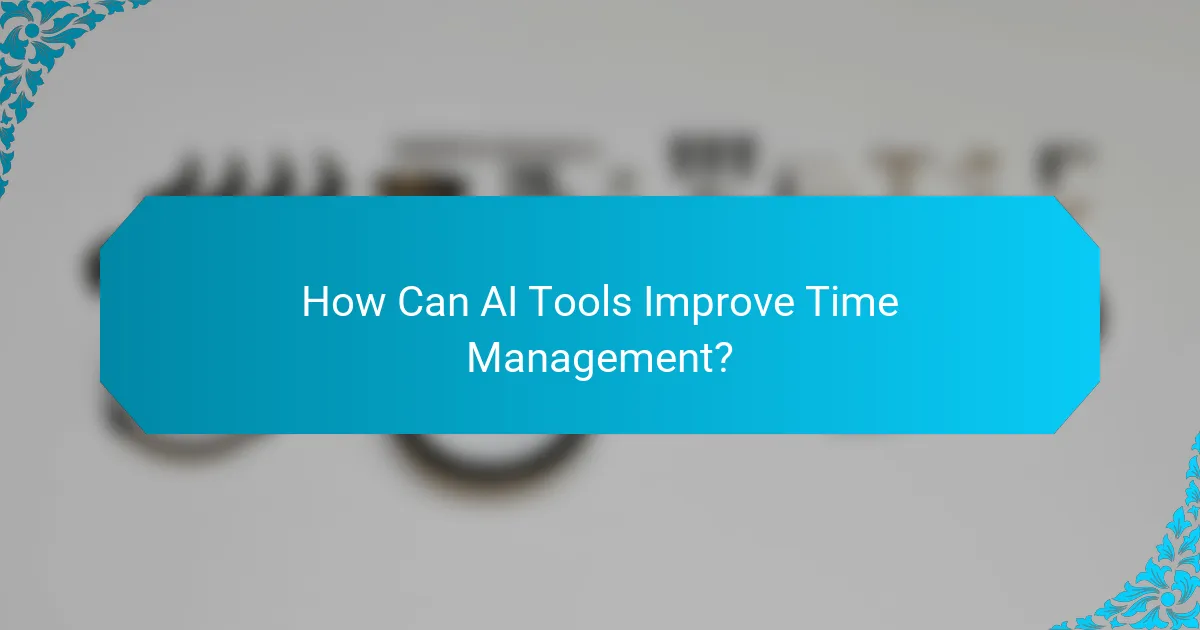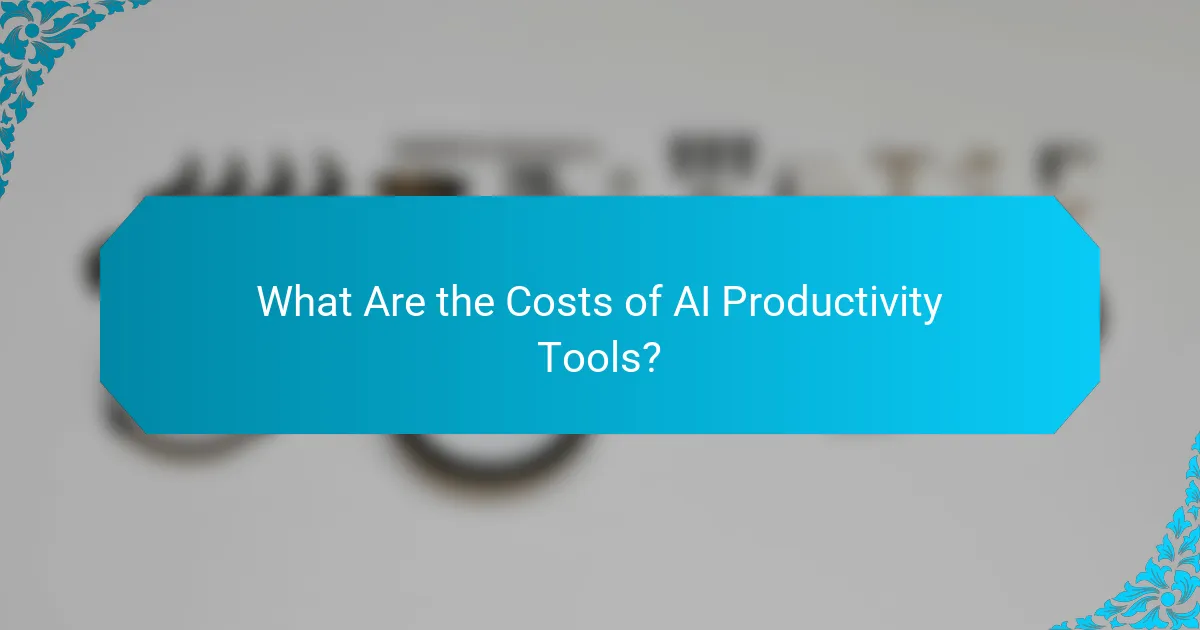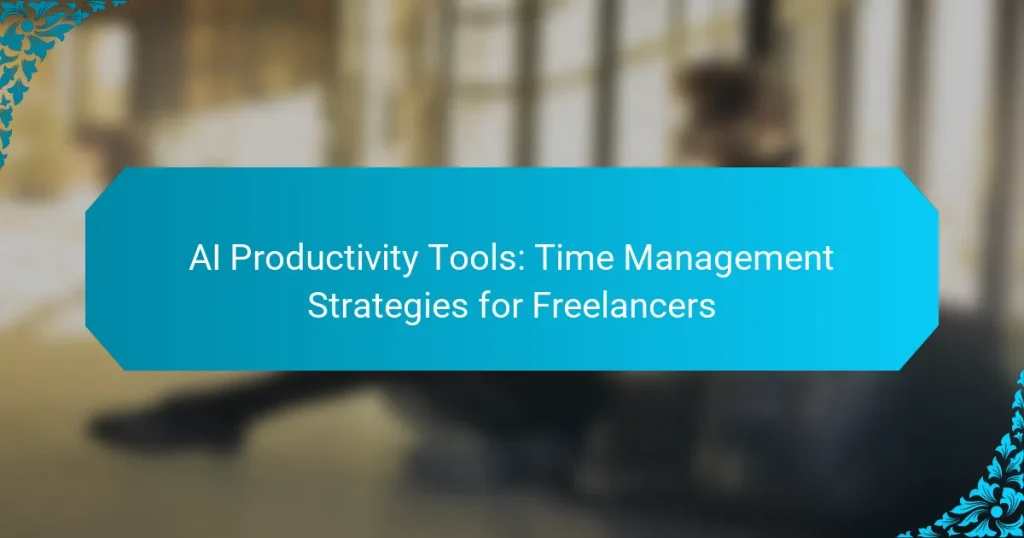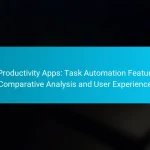Freelancers can significantly boost their productivity by leveraging AI tools designed for effective time management. These tools not only streamline task organization and collaboration but also automate repetitive processes, allowing freelancers to focus on their core work. By implementing strategies like time blocking and the Pomodoro technique, they can further enhance their efficiency and reduce stress in their daily routines.

What Are the Best AI Productivity Tools for Freelancers?
The best AI productivity tools for freelancers streamline task management, enhance collaboration, and improve time efficiency. These tools can help freelancers organize their projects, prioritize tasks, and track progress effectively.
Trello
Trello is a visual project management tool that uses boards, lists, and cards to help freelancers manage tasks. Users can create boards for different projects and move cards through various stages, making it easy to visualize progress.
To get started, create a board for each project and add cards for individual tasks. You can assign due dates, labels, and checklists to each card, which helps keep everything organized. Trello’s flexibility allows you to customize your workflow according to your needs.
Asana
Asana is a robust task management platform designed for team collaboration, but it’s equally effective for freelancers. It allows users to create tasks, set deadlines, and assign priorities, making it easier to manage workloads.
Freelancers can benefit from Asana’s project templates, which provide a structured approach to common tasks. Utilize features like task dependencies and subtasks to break down larger projects into manageable steps, ensuring nothing falls through the cracks.
Todoist
Todoist is a straightforward task manager that helps freelancers keep track of their to-do lists. Its clean interface allows for easy task entry, and you can categorize tasks by projects, labels, or priorities.
To maximize productivity, set recurring tasks for regular activities and use the “Karma” feature to track your progress over time. This can motivate you to stay on top of your workload and manage deadlines effectively.
Notion
Notion is an all-in-one workspace that combines note-taking, task management, and database functionality. Freelancers can use Notion to create custom dashboards that suit their workflow, integrating various aspects of project management in one place.
Consider using templates for project tracking and client management. Notion’s flexibility allows you to adapt it to your specific needs, whether you prefer a calendar view, kanban board, or simple lists.
ClickUp
ClickUp is a comprehensive productivity tool that offers features for task management, time tracking, and goal setting. It caters to freelancers by providing customizable views and extensive integrations with other apps.
Utilize ClickUp’s time tracking feature to monitor how long you spend on tasks, which can help with billing clients accurately. The ability to create different task views, such as lists, boards, or Gantt charts, allows you to choose the layout that works best for your workflow.

How Can AI Tools Improve Time Management?
AI tools enhance time management for freelancers by automating repetitive tasks, providing insights into productivity patterns, and optimizing workflows. These technologies help users allocate their time more effectively, ultimately leading to increased efficiency and reduced stress.
Automated task scheduling
Automated task scheduling allows freelancers to streamline their daily activities by using AI to organize and prioritize tasks. These tools can analyze deadlines, workload, and personal preferences to create an optimized schedule that adapts to changing circumstances.
For example, platforms like Trello or Asana can integrate AI to suggest the best times for meetings or project milestones based on your availability and past behavior. This reduces the time spent on planning and increases focus on completing tasks.
Time tracking features
Time tracking features in AI tools provide freelancers with insights into how their time is spent across various projects. By automatically logging hours and categorizing activities, these tools help identify time drains and areas for improvement.
Tools like Toggl or Clockify can generate reports that show how much time is allocated to different tasks, allowing freelancers to adjust their strategies. Regularly reviewing these insights can lead to better time allocation and increased productivity.
Prioritization algorithms
Prioritization algorithms in AI tools assist freelancers in determining which tasks should be tackled first based on urgency and importance. These algorithms analyze factors such as deadlines, project significance, and personal goals to create a prioritized task list.
For instance, tools like Todoist use AI to suggest which tasks to focus on each day, helping freelancers manage their workload effectively. This can prevent overwhelm and ensure that critical tasks are completed on time.

What Time Management Strategies Should Freelancers Use?
Freelancers can enhance their productivity by implementing effective time management strategies such as time blocking, the Pomodoro technique, and daily planning. These methods help structure work hours, maintain focus, and prioritize tasks efficiently.
Time blocking
Time blocking involves dividing your workday into specific segments dedicated to particular tasks or activities. This technique helps freelancers allocate their time effectively, reducing distractions and enhancing focus. For example, you might block out 9 AM to 11 AM for client work, 11 AM to 12 PM for emails, and 1 PM to 3 PM for project development.
To implement time blocking, start by identifying your most important tasks for the day. Use a calendar tool to visually map out your blocks, ensuring you include breaks to recharge. Avoid the common pitfall of over-scheduling; aim for a balance that allows flexibility for unexpected tasks.
Pomodoro technique
The Pomodoro technique is a time management method that encourages focused work sessions followed by short breaks. Typically, you work for 25 minutes, then take a 5-minute break, repeating this cycle to maintain productivity. After four cycles, a longer break of 15-30 minutes is recommended.
This approach can help freelancers maintain concentration and prevent burnout. To get started, use a timer or a dedicated app to track your sessions. Be mindful not to extend work periods beyond the recommended time, as this can lead to decreased focus and effectiveness.
Daily planning
Daily planning involves setting aside time each day to outline tasks and goals. This strategy helps freelancers prioritize their workload and ensures they stay on track throughout the day. A simple method is to create a to-do list each morning or the night before.
When planning, consider categorizing tasks by urgency and importance. Tools like digital planners or simple sticky notes can be effective. Avoid the mistake of overloading your daily plan; aim for a manageable number of tasks to maintain a sense of accomplishment and motivation.

How to Choose the Right AI Productivity Tool?
Choosing the right AI productivity tool involves understanding your specific needs, evaluating the user interface, and considering integration capabilities. These factors ensure that the tool enhances your time management and overall productivity as a freelancer.
Assessing specific needs
Start by identifying the tasks you want to automate or improve. For instance, if you struggle with scheduling, look for tools that specialize in calendar management or time tracking. Consider whether you need features like project management, invoicing, or client communication.
Make a list of must-have features versus nice-to-have ones. This prioritization helps narrow down your options and ensures you select a tool that aligns with your workflow.
Evaluating user interface
The user interface (UI) should be intuitive and easy to navigate. A clean design can significantly reduce the learning curve, allowing you to focus on productivity rather than figuring out how to use the tool. Look for tools that offer customizable dashboards to suit your preferences.
Consider testing a few options through free trials. This hands-on experience will help you gauge how comfortable you feel using the tool in your daily tasks.
Considering integration capabilities
Integration with other tools you already use is crucial for seamless workflow. Check if the AI productivity tool can connect with your email, calendar, or project management software. This connectivity can save you time and reduce the need to switch between applications.
Review the API capabilities of the tool if you require more advanced integrations. Tools that support popular platforms like Zapier can offer greater flexibility in automating tasks across different applications.

What Are the Costs of AI Productivity Tools?
The costs of AI productivity tools can vary significantly based on features, functionality, and whether the options are free or paid. Understanding these costs helps freelancers make informed decisions that align with their budget and productivity needs.
Free vs. paid options
Free AI productivity tools often provide basic functionalities, making them suitable for freelancers just starting or those with limited budgets. However, these tools may lack advanced features such as integrations, automation, or customer support.
Paid options typically offer more robust capabilities, including enhanced analytics, priority support, and regular updates. Prices can range from low monthly fees to higher annual subscriptions, depending on the tool’s complexity and the number of users.
Subscription pricing models
Many AI productivity tools operate on subscription pricing models, which can be monthly or annually. Monthly subscriptions allow for flexibility, while annual plans often come with discounts, making them more cost-effective for long-term users.
Freelancers should consider their usage patterns when selecting a subscription model. If a tool is used frequently, an annual plan may save money, whereas infrequent users might benefit from a monthly subscription.
Cost-benefit analysis
Conducting a cost-benefit analysis involves comparing the costs of the tool against the potential productivity gains. For instance, if a tool saves several hours a week, the time saved can translate into increased earnings that outweigh the subscription cost.
Freelancers should evaluate the specific features they need and how those features can enhance their workflow. A tool that costs $20 per month might be worth it if it saves 5 hours of work time, equating to a higher hourly rate.

What Are the Common Challenges in Time Management?
Freelancers often face several challenges in time management that can hinder productivity. Key issues include procrastination, distractions, and difficulty in prioritizing tasks effectively.
Procrastination
Procrastination is a prevalent challenge for freelancers, often stemming from fear of failure, perfectionism, or lack of motivation. It can lead to missed deadlines and increased stress, ultimately affecting the quality of work.
To combat procrastination, freelancers can employ strategies such as breaking tasks into smaller, manageable steps and setting specific deadlines for each. For instance, instead of aiming to complete an entire project at once, focus on finishing one section at a time.
Additionally, using tools like timers can help maintain focus. Techniques such as the Pomodoro Technique, which involves working for 25 minutes followed by a 5-minute break, can enhance productivity and reduce the tendency to procrastinate.


